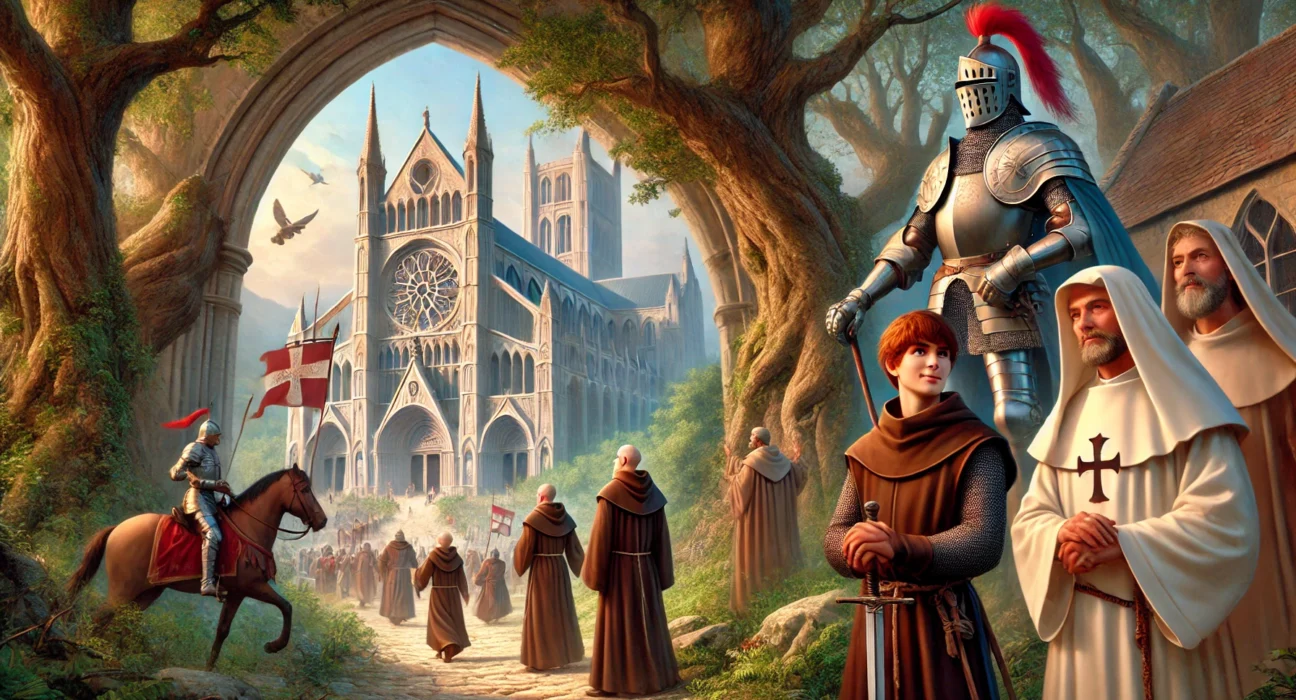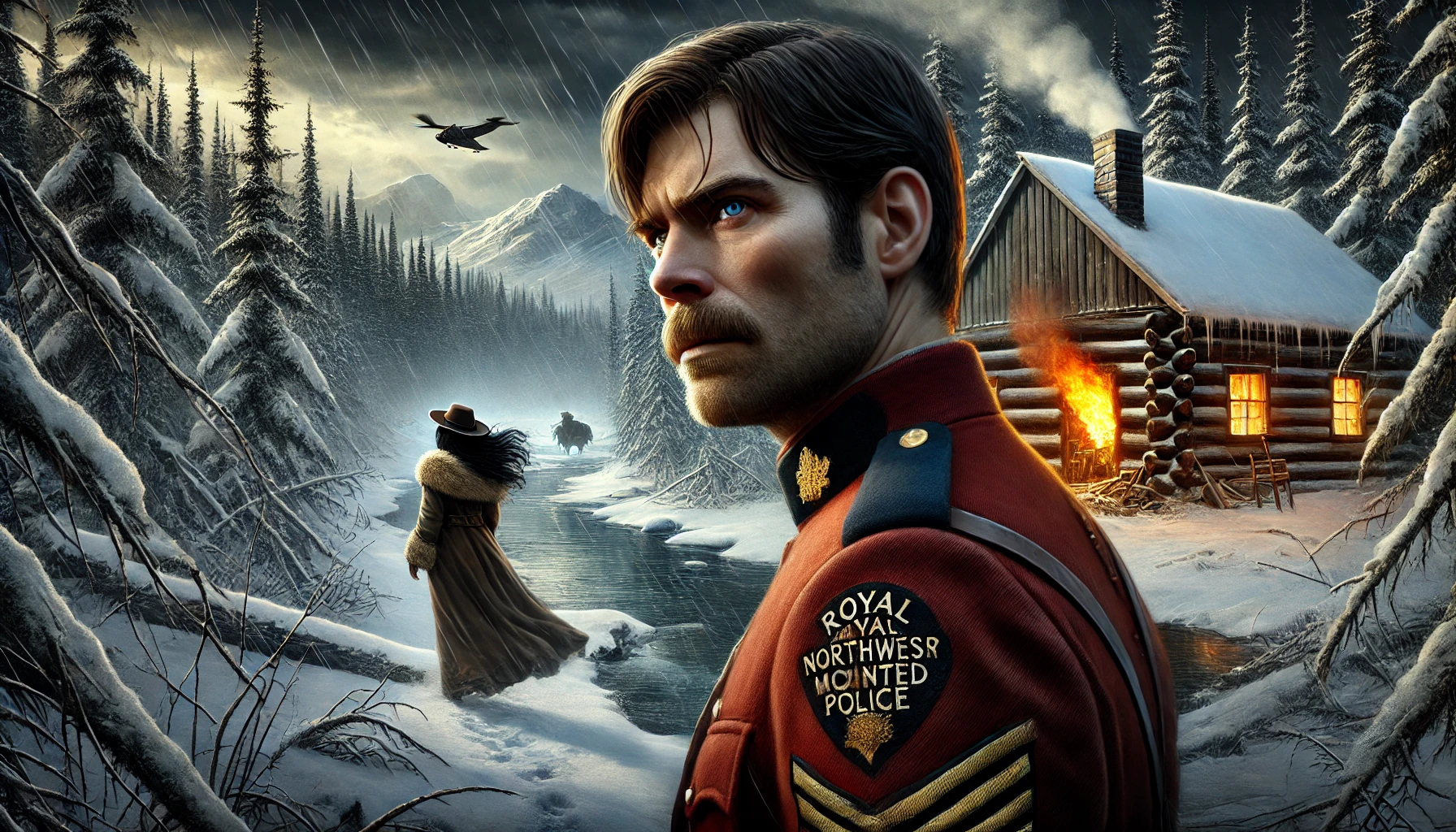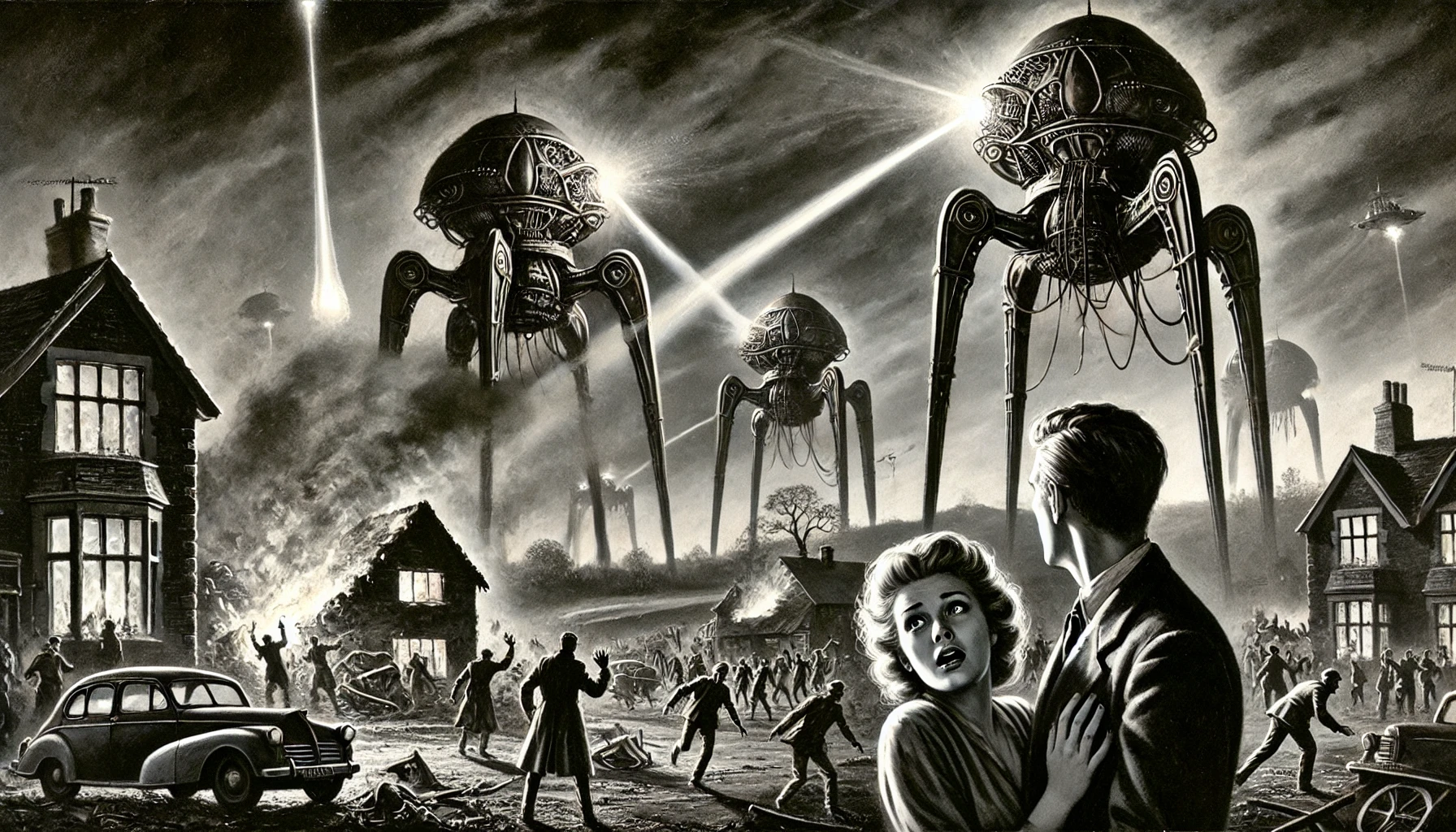The White Company by Sir Arthur Conan Doyle, first published in 1891, is a historical adventure novel set during the Hundred Years’ War. The story follows a group of English archers and knights, focusing on their adventures as mercenaries during a period of medieval warfare. With its vivid depictions of chivalric values, camaraderie, and knightly honor, The White Company blends historical fiction with action and moral exploration.
Plot Summary
On a summer afternoon in the peaceful Abbey of Beaulieu, the great bell rings unexpectedly, calling all the monks back to the cloisters. Among them is Alleyne Edricson, a gentle and kind-hearted novice who has spent his entire life within the abbey walls. As the son of a local Franklin, Alleyne was promised to the abbey in infancy after his mother died and his father sought a safe haven for him. But now, on his twentieth birthday, his time at the abbey comes to an end. He is sent into the world to learn its ways, according to his father’s will.
With the Abbot’s blessing, Alleyne leaves the abbey, unsure of what awaits him. He carries little more than his innocence and the teachings of the monks. His first destination is Minstead, where his older brother, the harsh and fierce Socman of Minstead, rules the family estate. But before he reaches his brother’s home, he meets two remarkable men. First, he encounters Hordle John, a massive, red-headed monk who has just been expelled from Beaulieu for his unruly behavior. John’s defiant spirit and larger-than-life personality make him an odd but loyal companion for the soft-spoken Alleyne.
Soon after, they meet Samkin Aylward, a seasoned archer and veteran of many battles. Aylward, with his infectious humor and love of adventure, is recruiting men for a famous mercenary group known as the White Company, commanded by the honorable Sir Nigel Loring. The trio bonds quickly, and Aylward suggests that Alleyne’s talents would be wasted in the church, urging him to join Sir Nigel’s service instead.
Alleyne’s visit to his brother is brief and bitter. His brother, angry and jealous, is nothing like the family Alleyne hoped to find. After a violent confrontation, Alleyne leaves Minstead and decides to join his new friends on their journey. Together, they set out for Sir Nigel’s manor in Hampshire, where Alleyne’s fate becomes intertwined with the knight’s family and the larger world beyond England’s shores.
At Sir Nigel’s manor, Alleyne meets Lady Maude Loring, Sir Nigel’s daughter. She is proud, sharp-witted, and fiercely independent. Though initially dismissive of Alleyne due to his humble demeanor, Maude’s attitude softens as she comes to see the depth of his character and intellect. Their blossoming affection, however, is complicated by Alleyne’s modest upbringing and his sense of unworthiness. He is not yet ready to reveal his feelings, and the demands of duty soon call him away.
Sir Nigel, a small but gallant knight, leads the White Company, a renowned band of archers and men-at-arms. He is a man of honor and chivalry, driven by the desire to uphold the old ways of knighthood. Sir Nigel’s loyalty to the English crown calls him to arms once again, and the White Company embarks on a journey across the English Channel to fight in the wars of France.
The White Company, with Alleyne, John, and Aylward among them, marches through the French countryside. Along the way, they face battles, sieges, and skirmishes that test their courage and resolve. The warriors’ camaraderie deepens as they navigate the perils of war, finding solace in their shared loyalty to Sir Nigel and each other.
Alleyne, still untested in the ways of war, finds himself quickly hardened by the brutal realities of battle. He witnesses the horrors of war and the glory that comes with victory, but he remains steadfast in his principles. Though he is not a man of violence by nature, his skill with arms grows, and he earns the respect of his fellow soldiers.
Sir Nigel’s leadership shines on the battlefield, but it is his personal honor that makes him a beloved figure among his men. His exploits are bold and daring, yet he remains humble and true to the knightly code. Even when faced with overwhelming odds, Sir Nigel’s unwavering sense of duty pushes him forward, inspiring those around him.
Amidst the campaigns in France, Alleyne’s love for Lady Maude never leaves his thoughts. The letters he writes to her, filled with tender affection and longing, reveal a man deeply in love but uncertain of his place in the world. Maude, far away in England, waits for news of the White Company, her own feelings for Alleyne growing stronger with each passing day.
As the war draws to a close, Sir Nigel’s valor is rewarded, but at great personal cost. In a final act of heroism, Sir Nigel is grievously wounded, and the once-proud knight is left in a state of frailty. The White Company returns to England, victorious but forever changed by the trials of war. Alleyne, having proven himself on the battlefield, returns not as the quiet novice who left the abbey but as a man of honor, strength, and confidence.
Upon his return, Alleyne seeks out Lady Maude, determined to finally declare his love. Their reunion is filled with joy and mutual understanding, and they soon marry, uniting their fates. Alleyne’s journey from the peaceful cloisters of Beaulieu to the battlefields of France has shaped him into a man worthy of her love and respect.
Hordle John and Samkin Aylward, ever the loyal companions, remain by Alleyne’s side, celebrating his happiness while continuing to pursue their own adventures. The bonds formed in war are not easily broken, and the trio remains inseparable, united by their shared experiences and enduring friendship.
As Alleyne and Maude settle into their life together, they reflect on the trials and triumphs that have brought them to this moment. The peace they now enjoy stands in stark contrast to the chaos of the world they left behind, a testament to the resilience of love and the power of honor. In the end, Alleyne’s journey has come full circle, from the quiet halls of the abbey to the heart of the world, where he has found both his purpose and his place.
Main Characters
- Alleyne Edricson: The protagonist, Alleyne, begins his journey as a novice monk raised in a Cistercian abbey. He is depicted as gentle, intelligent, and morally upright, which contrasts with the violent and chaotic world he encounters. His growth into a capable and honorable man is central to the story.
- John Hordle (Hordle John): A large and robust man with a fiery personality, Hordle John leaves the monastic life and becomes one of Alleyne’s close companions. He brings humor, strength, and a rebellious spirit to the narrative.
- Sir Nigel Loring: An experienced knight who commands the White Company, Sir Nigel embodies the ideals of knighthood—bravery, loyalty, and a sense of duty. He serves as a mentor figure, especially for Alleyne.
- Samkin Aylward: A jovial and skilled archer who is a veteran of many battles. Samkin adds humor and camaraderie to the group while displaying a strong sense of loyalty to his comrades.
Theme
- Chivalry and Honor: Central to the narrative is the medieval code of chivalry, where personal honor, loyalty, and courage drive the actions of the main characters. The novel explores how these values contrast with the grim realities of war.
- Coming of Age: Alleyne’s journey is as much about personal growth as it is about adventure. He transforms from a sheltered, pious monk into a capable and honorable man, learning to balance his moral compass with the demands of the world.
- War and Brotherhood: The novel paints a vivid picture of the camaraderie among soldiers, especially within the White Company. Their loyalty to each other is depicted as both a necessity in warfare and a source of strength and comfort.
- Class and Society: The novel also delves into the hierarchical society of medieval England, with a focus on the interactions between nobles, knights, and common soldiers. These dynamics add depth to the character relationships and the broader social context.
Writing Style and Tone
Arthur Conan Doyle’s writing in The White Company is rich in historical detail and imbued with a romantic view of knighthood. His descriptions are vivid, bringing medieval England and its battlefields to life through imagery and meticulous attention to period accuracy. The action scenes are fast-paced and gripping, creating a sense of immediacy and excitement. Doyle’s use of dialogue is equally noteworthy, reflecting both the speech patterns and social norms of the time, while maintaining accessibility for modern readers.
The tone of the novel oscillates between light-hearted camaraderie and more serious reflections on war and morality. The humor brought by characters like Hordle John and Samkin Aylward offers a counterbalance to the heavier themes, while the romanticized view of chivalry gives the novel an idealistic and somewhat nostalgic feel. However, the darker realities of medieval warfare and societal inequalities are also present, grounding the story in a more complex moral landscape.
We hope this summary has sparked your interest and would appreciate you following Celsius 233 on social media:
There’s a treasure trove of other fascinating book summaries waiting for you. Check out our collection of stories that inspire, thrill, and provoke thought, just like this one by checking out the Book Shelf or the Library
Remember, while our summaries capture the essence, they can never replace the full experience of reading the book. If this summary intrigued you, consider diving into the complete story – buy the book and immerse yourself in the author’s original work.
If you want to request a book summary, click here.
When Saurabh is not working/watching football/reading books/traveling, you can reach him via Twitter/X, LinkedIn, or Threads
Restart reading!








